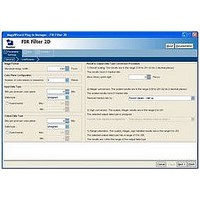IPS-VIDEO Altera, IPS-VIDEO Datasheet - Page 129

IPS-VIDEO
Manufacturer Part Number
IPS-VIDEO
Description
MegaCore Suite W/ 17 DSP Video/image Processing Functions
Manufacturer
Altera
Type
-r
Specifications of IPS-VIDEO
Software Application
IP CORE, SUITES
Supported Families
Arria GX, Cyclone II, HardCopy II, Stratix II
Core Architecture
FPGA
Core Sub-architecture
Arria, Cyclone, Stratix
Rohs Compliant
NA
Function
Suite of IP Functions for Video and Image Processing
License
Initial License
Lead Free Status / RoHS Status
na
Lead Free Status / RoHS Status
na
- Current page: 129 of 214
- Download datasheet (6Mb)
Chapter 5: Functional Descriptions
Deinterlacer
May 2011 Altera Corporation
Frame Rate Conversion
Behavior When Unexpected Fields are Received
When you select triple-buffering, the decision to drop and repeat frames is based on
the status of the spare buffer. Because the input and output sides are not tightly
synchronized, the behavior of the Deinterlacer is not completely deterministic and can
be affected by the burstiness of the data in the video system. This may cause
undesirable glitches or jerky motion in the video output.
By using a double-buffer and controlling the dropping/repeating behavior, the input
and output can be kept synchronized. For example, if the input has 60 interlaced
fields per second, but the output requires 50 progressive frames per second (fps),
setting the input frame rate to 30 fps and the output frame rate at 50 fps guarantees
that exactly one frame in six is dropped.
To control the dropping/repeating behavior and to synchronize the input and output
sides, you must select double-buffering mode and turn on Run-time control for
locked frame rate conversion in the Parameter Settings tab of the parameter editor.
The input and output rates can be selected and changed at run time.
page 7–9
The rate conversion algorithm is fully compatible with a progressive input stream
when the progressive passthrough mode is enabled but it cannot be enabled
simultaneously with the run-time override of the motion-adaptive algorithm.
So far, the behavior of the Deinterlacer has been described assuming an uninterrupted
sequence of pairs of interlaced fields (F0, F1, F0, …) each having the same height.
Some video streams might not follow this rule and the Deinterlacer adapts its
behavior in such cases.
The dimensions and type of a field (progressive, interlaced F0, or interlaced F1) are
identified using information contained in Avalon-ST Video control packets. When a
field is received without control packets, its type is defined by the type of the previous
field. A field following a progressive field is assumed to be a progressive field and a
field following an interlaced F0 or F1 field is respectively assumed to be an interlaced
F1 or F0 field. If the first field received after reset is not preceded by a control packet, it
is assumed to be an interlaced field and the default initial field (F0 or F1) specified in
the parameter editor is used.
When the weave or the motion-adaptive algorithms are used, a regular sequence of
pairs of fields is expected. Subsequent F0 fields received after an initial F0 field or
subsequent F1 fields received after an initial F1 field are immediately discarded.
When the bob algorithm is used and synchronization is done on a specific field (input
frame rate = output frame rate), the field that is constantly unused is always
discarded. The other field is used to build a progressive frame, unless it is dropped by
the triple-buffering algorithm.
describes the control register map.
Video and Image Processing Suite User Guide
Table 7–8 on
5–45
Related parts for IPS-VIDEO
Image
Part Number
Description
Manufacturer
Datasheet
Request
R

Part Number:
Description:
CYCLONE II STARTER KIT EP2C20N
Manufacturer:
Altera
Datasheet:

Part Number:
Description:
CPLD, EP610 Family, ECMOS Process, 300 Gates, 16 Macro Cells, 16 Reg., 16 User I/Os, 5V Supply, 35 Speed Grade, 24DIP
Manufacturer:
Altera Corporation
Datasheet:

Part Number:
Description:
CPLD, EP610 Family, ECMOS Process, 300 Gates, 16 Macro Cells, 16 Reg., 16 User I/Os, 5V Supply, 15 Speed Grade, 24DIP
Manufacturer:
Altera Corporation
Datasheet:

Part Number:
Description:
Manufacturer:
Altera Corporation
Datasheet:

Part Number:
Description:
CPLD, EP610 Family, ECMOS Process, 300 Gates, 16 Macro Cells, 16 Reg., 16 User I/Os, 5V Supply, 30 Speed Grade, 24DIP
Manufacturer:
Altera Corporation
Datasheet:

Part Number:
Description:
High-performance, low-power erasable programmable logic devices with 8 macrocells, 10ns
Manufacturer:
Altera Corporation
Datasheet:

Part Number:
Description:
High-performance, low-power erasable programmable logic devices with 8 macrocells, 7ns
Manufacturer:
Altera Corporation
Datasheet:

Part Number:
Description:
Classic EPLD
Manufacturer:
Altera Corporation
Datasheet:

Part Number:
Description:
High-performance, low-power erasable programmable logic devices with 8 macrocells, 10ns
Manufacturer:
Altera Corporation
Datasheet:

Part Number:
Description:
Manufacturer:
Altera Corporation
Datasheet:











